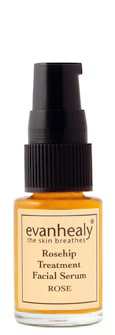Since high school, I’ve sat in many dermatologist’s offices and tried a slew of very unglamorous pastes and gels—all in an effort to combat my combative skin. Some dried brown, some dried chalky, some bleached my clothes (and school books!) if I forgot to wash my hands immediately after applying it. (Probably a sign of something awful.)
I don’t remember half of what I used (hint: it didn’t help, whatever it was), but I do remember using a retinoid cream. It was the only topical prescription that I’ve had refilled, and I still use it. It’s one of the few synthetic products I allow myself because my skin does not look the same with out it.
My prescription is pretty strong, so I only use it a few times a week. My current tube will probably last forever, but when forever ends, I may switch to an over-counter retinol cream (whose ingredients I can research) or simply rely on a natural alternative (more on that below!).
What is retinol?
A retinoid is a prescription cream that comes in three strengths: tretinoin, tazarotene, and adapalene—tazarotene being the strongest, adapalene being the gentlest. A retinol is an over-the-counter treatment.
OTC retinols are lower in strength and make take up to 12 weeks to deliver on their promises (while prescription creams usually take only a month). I will use the terms retinoid and retinol interchangeably since they refer to different strengths of the same stuff.
Both contain derivatives of retinoic acid, a form of vitamin A. Acting as both a peel and an antioxidant, retinol help erase fine lines and hyper-pigmentation from sun spots and acne scarring. If this sounds too good to be true, it’s not. Vitamin A is—as far as we know—the only substance that can actually undo damage. (Other antioxidant superstars help prevent damage, make skin brighter, etc.)
How does it work?
If you’ve ever noticed skin sensitivity while using a retinoid, that’s your skin exfoliating (shedding dead skin cells) at a faster rate than it would left to its own devices. If you’ve ever done a peel or even just exfoliated with a scrub, you may have felt something similar. Retinoids increase the rate of cell turn over—which is why they appear to make your acne heal faster.
According to demonologist Leslie Baumann, retinol is more than a peel-like exfoliator, however: “It has so many more benefits that peels do not have. It increases collagen production and helps keep the collagen-producing genes turned on.”
It accomplishes this by actually thickening the dermal layer of skin. The dermis is responsible for collagen, elastin, and hyaluronic acid (gives skin plumpness). The dermis thins as we age, reducing this skin-beautifying components.
Is it right for me?
Retinol can be effective for teens struggling with acne—or women in their eighties looking to reduce age spots—or a twenty-something trying to fade acne scars and prevent fine lines like yours truly.
While retinoids can initially increase skin sensitivity, most skin types can tolerate them if the cream is gradually worked into a skincare regimen.
Is it safe?
It’s a common belief that retinols increase skin’s sensitivity to the sun, but they do only as much as any other form of exfoliation. Retinoic acid itself is sensitive to the sun, however, meaning that it loses its effectiveness when exposed to light. Retinol creams should therefore always be applied at night. As you would normally, wear a healthy layer of sunscreen during the day.
With both OTC and prescription creams, you do run the risk of encountering not-so-clean synthetic ingredients. Vitamin A can also be toxic in high doses. Normally a pea-sized amount it plenty, however. More may be too harsh for any skin type.
What’s perhaps more concerning is the potential overall hazard determined by the Environmental Working Group (EWG). For one, retinoid acid is a known reproductive toxin.
And what’s more—it may not always be vegan. Some retinoic acid may be derived from fish liver oil or egg yolks, and determining the source of an ingredient in a prescription cream can be challenging. I always assumed mine was purely synthetic, and only in researching for this article did I realize that I have no idea where that stuff comes from. (That’s not a feeling I like!)
Are there natural alternatives?
Yes! Natural sources of vitamin A—like rosehip seed oil—will promote collagen production and reduce fine line over time. The results may happen more slowly, but you’re also getting the benefit of the using a more whole substance, which always appeals to me.

Rosehip Treatment Facial Serum by Evan Healy.
Since I’ve incorporated rosehip seed oil into my routine, I only use my retinoid about once or twice a week. As Juhea writes in her advice for twenty-somethings, rosehip seed oil is “like a Valencia filter on you at all times and works better than expensive creams.” I concur–which is one reason why, as I mentioned above, I probably won’t refill my retinoid perception.
That being said, I can certainly sympathize with those who may desire something stronger until their skin is more balanced. I’ve been there. Whichever route you decide, rest assured that vitamin A–natural or synthetic–is the real deal.
Also see: Natural Beauty – DIY Exfoliating Powder
The Best Natural Oil for Your Skin Type
Beauty Review: Humble + Lavi Skincare
Photos: Ben Raynal via Flickr, Evan Healy





